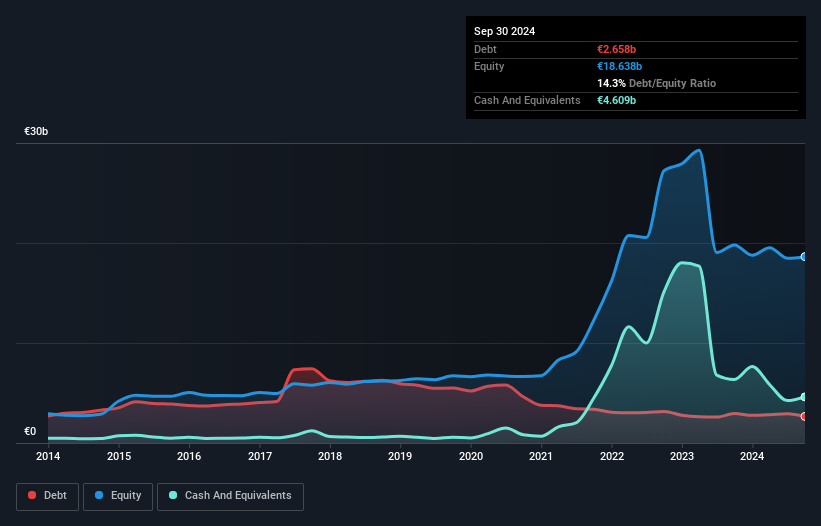- Germany
- /
- Marine and Shipping
- /
- XTRA:HLAG
These 4 Measures Indicate That Hapag-Lloyd (ETR:HLAG) Is Using Debt Reasonably Well
The external fund manager backed by Berkshire Hathaway's Charlie Munger, Li Lu, makes no bones about it when he says 'The biggest investment risk is not the volatility of prices, but whether you will suffer a permanent loss of capital.' When we think about how risky a company is, we always like to look at its use of debt, since debt overload can lead to ruin. As with many other companies Hapag-Lloyd Aktiengesellschaft (ETR:HLAG) makes use of debt. But should shareholders be worried about its use of debt?
Why Does Debt Bring Risk?
Generally speaking, debt only becomes a real problem when a company can't easily pay it off, either by raising capital or with its own cash flow. In the worst case scenario, a company can go bankrupt if it cannot pay its creditors. While that is not too common, we often do see indebted companies permanently diluting shareholders because lenders force them to raise capital at a distressed price. Of course, debt can be an important tool in businesses, particularly capital heavy businesses. The first step when considering a company's debt levels is to consider its cash and debt together.
Check out our latest analysis for Hapag-Lloyd
What Is Hapag-Lloyd's Debt?
You can click the graphic below for the historical numbers, but it shows that Hapag-Lloyd had €2.66b of debt in September 2024, down from €2.94b, one year before. However, its balance sheet shows it holds €4.61b in cash, so it actually has €1.95b net cash.

How Strong Is Hapag-Lloyd's Balance Sheet?
We can see from the most recent balance sheet that Hapag-Lloyd had liabilities of €6.52b falling due within a year, and liabilities of €4.96b due beyond that. On the other hand, it had cash of €4.61b and €2.57b worth of receivables due within a year. So its liabilities outweigh the sum of its cash and (near-term) receivables by €4.31b.
Since publicly traded Hapag-Lloyd shares are worth a very impressive total of €28.9b, it seems unlikely that this level of liabilities would be a major threat. Having said that, it's clear that we should continue to monitor its balance sheet, lest it change for the worse. Despite its noteworthy liabilities, Hapag-Lloyd boasts net cash, so it's fair to say it does not have a heavy debt load!
In fact Hapag-Lloyd's saving grace is its low debt levels, because its EBIT has tanked 74% in the last twelve months. Falling earnings (if the trend continues) could eventually make even modest debt quite risky. When analysing debt levels, the balance sheet is the obvious place to start. But it is future earnings, more than anything, that will determine Hapag-Lloyd's ability to maintain a healthy balance sheet going forward. So if you want to see what the professionals think, you might find this free report on analyst profit forecasts to be interesting.
Finally, while the tax-man may adore accounting profits, lenders only accept cold hard cash. While Hapag-Lloyd has net cash on its balance sheet, it's still worth taking a look at its ability to convert earnings before interest and tax (EBIT) to free cash flow, to help us understand how quickly it is building (or eroding) that cash balance. Happily for any shareholders, Hapag-Lloyd actually produced more free cash flow than EBIT over the last three years. That sort of strong cash conversion gets us as excited as the crowd when the beat drops at a Daft Punk concert.
Summing Up
Although Hapag-Lloyd's balance sheet isn't particularly strong, due to the total liabilities, it is clearly positive to see that it has net cash of €1.95b. And it impressed us with free cash flow of €1.4b, being 104% of its EBIT. So we are not troubled with Hapag-Lloyd's debt use. When analysing debt levels, the balance sheet is the obvious place to start. But ultimately, every company can contain risks that exist outside of the balance sheet. Be aware that Hapag-Lloyd is showing 4 warning signs in our investment analysis , and 2 of those can't be ignored...
Of course, if you're the type of investor who prefers buying stocks without the burden of debt, then don't hesitate to discover our exclusive list of net cash growth stocks, today.
Valuation is complex, but we're here to simplify it.
Discover if Hapag-Lloyd might be undervalued or overvalued with our detailed analysis, featuring fair value estimates, potential risks, dividends, insider trades, and its financial condition.
Access Free AnalysisHave feedback on this article? Concerned about the content? Get in touch with us directly. Alternatively, email editorial-team (at) simplywallst.com.
This article by Simply Wall St is general in nature. We provide commentary based on historical data and analyst forecasts only using an unbiased methodology and our articles are not intended to be financial advice. It does not constitute a recommendation to buy or sell any stock, and does not take account of your objectives, or your financial situation. We aim to bring you long-term focused analysis driven by fundamental data. Note that our analysis may not factor in the latest price-sensitive company announcements or qualitative material. Simply Wall St has no position in any stocks mentioned.
About XTRA:HLAG
Flawless balance sheet with proven track record and pays a dividend.
Similar Companies
Market Insights
Community Narratives





